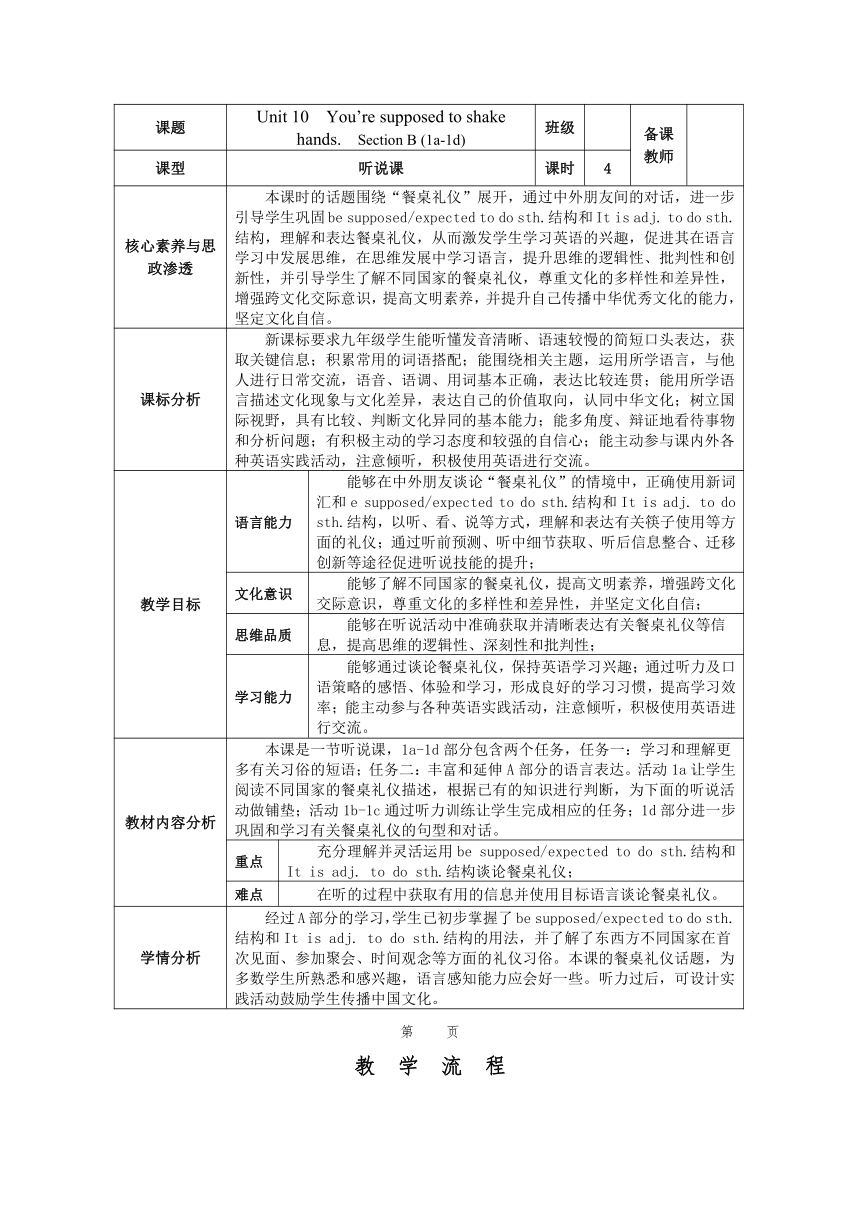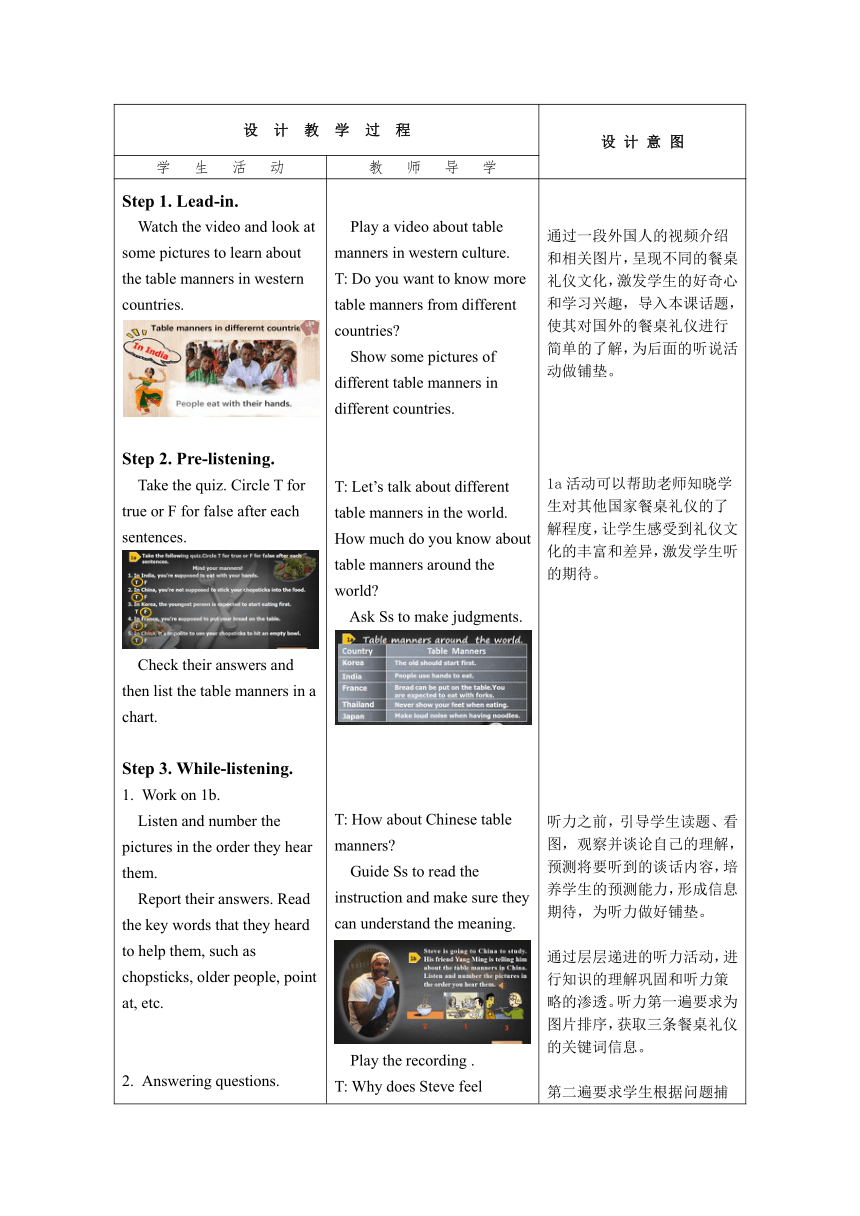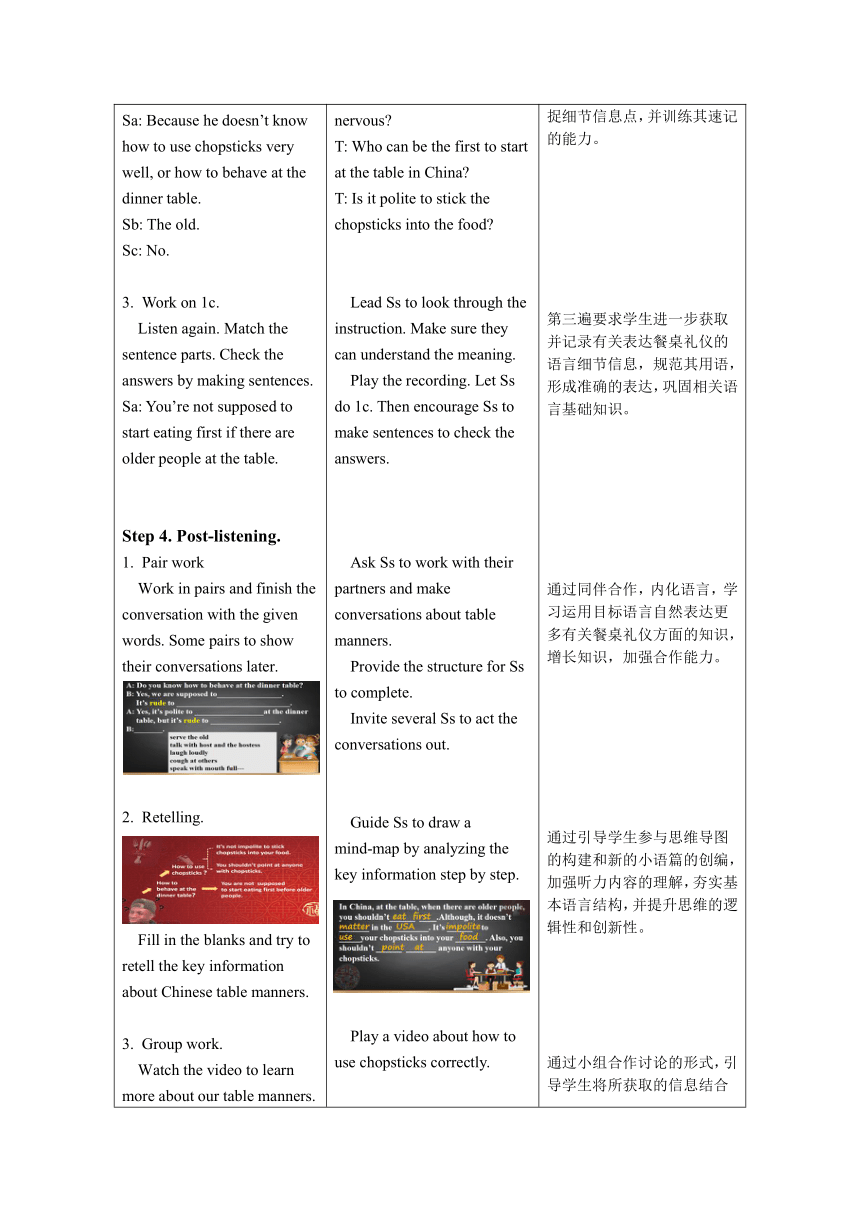【核心素养目标】 Unit 10 You’re supposed to shake hands. Section B (1a-1d) 表格式教案
文档属性
| 名称 | 【核心素养目标】 Unit 10 You’re supposed to shake hands. Section B (1a-1d) 表格式教案 |  | |
| 格式 | docx | ||
| 文件大小 | 1.5MB | ||
| 资源类型 | 教案 | ||
| 版本资源 | 人教新目标(Go for it)版 | ||
| 科目 | 英语 | ||
| 更新时间 | 2024-09-24 14:53:05 | ||
图片预览



文档简介
课题 Unit 10 You’re supposed to shake hands. Section B (1a-1d) 班级 备课教师
课型 听说课 课时 4
核心素养与思政渗透 本课时的话题围绕“餐桌礼仪”展开,通过中外朋友间的对话,进一步引导学生巩固be supposed/expected to do sth.结构和It is adj. to do sth.结构,理解和表达餐桌礼仪,从而激发学生学习英语的兴趣,促进其在语言学习中发展思维,在思维发展中学习语言,提升思维的逻辑性、批判性和创新性,并引导学生了解不同国家的餐桌礼仪,尊重文化的多样性和差异性,增强跨文化交际意识,提高文明素养,并提升自己传播中华优秀文化的能力,坚定文化自信。
课标分析 新课标要求九年级学生能听懂发音清晰、语速较慢的简短口头表达,获取关键信息;积累常用的词语搭配;能围绕相关主题,运用所学语言,与他人进行日常交流,语音、语调、用词基本正确,表达比较连贯;能用所学语言描述文化现象与文化差异,表达自己的价值取向,认同中华文化;树立国际视野,具有比较、判断文化异同的基本能力;能多角度、辩证地看待事物和分析问题;有积极主动的学习态度和较强的自信心;能主动参与课内外各种英语实践活动,注意倾听,积极使用英语进行交流。
教学目标 语言能力 能够在中外朋友谈论“餐桌礼仪”的情境中,正确使用新词汇和e supposed/expected to do sth.结构和It is adj. to do sth.结构,以听、看、说等方式,理解和表达有关筷子使用等方面的礼仪;通过听前预测、听中细节获取、听后信息整合、迁移创新等途径促进听说技能的提升;
文化意识 能够了解不同国家的餐桌礼仪,提高文明素养,增强跨文化交际意识,尊重文化的多样性和差异性,并坚定文化自信;
思维品质 能够在听说活动中准确获取并清晰表达有关餐桌礼仪等信息,提高思维的逻辑性、深刻性和批判性;
学习能力 能够通过谈论餐桌礼仪,保持英语学习兴趣;通过听力及口语策略的感悟、体验和学习,形成良好的学习习惯,提高学习效率;能主动参与各种英语实践活动,注意倾听,积极使用英语进行交流。
教材内容分析 本课是一节听说课,1a-1d部分包含两个任务,任务一:学习和理解更多有关习俗的短语;任务二:丰富和延伸A部分的语言表达。活动1a让学生阅读不同国家的餐桌礼仪描述,根据已有的知识进行判断,为下面的听说活动做铺垫;活动1b-1c通过听力训练让学生完成相应的任务;1d部分进一步巩固和学习有关餐桌礼仪的句型和对话。
重点 充分理解并灵活运用be supposed/expected to do sth.结构和It is adj. to do sth.结构谈论餐桌礼仪;
难点 在听的过程中获取有用的信息并使用目标语言谈论餐桌礼仪。
学情分析 经过A部分的学习,学生已初步掌握了be supposed/expected to do sth.结构和It is adj. to do sth.结构的用法,并了解了东西方不同国家在首次见面、参加聚会、时间观念等方面的礼仪习俗。本课的餐桌礼仪话题,为多数学生所熟悉和感兴趣,语言感知能力应会好一些。听力过后,可设计实践活动鼓励学生传播中国文化。
第 页
教 学 流 程
设 计 教 学 过 程 设 计 意 图
学 生 活 动 教 师 导 学
Step 1. Lead-in. Watch the video and look at some pictures to learn about the table manners in western countries. Step 2. Pre-listening. Take the quiz. Circle T for true or F for false after each sentences. Check their answers and then list the table manners in a chart. Step 3. While-listening. Work on 1b. Listen and number the pictures in the order they hear them. Report their answers. Read the key words that they heard to help them, such as chopsticks, older people, point at, etc. Answering questions. Sa: Because he doesn’t know how to use chopsticks very well, or how to behave at the dinner table. Sb: The old. Sc: No. Work on 1c. Listen again. Match the sentence parts. Check the answers by making sentences. Sa: You’re not supposed to start eating first if there are older people at the table. Step 4. Post-listening. Pair work Work in pairs and finish the conversation with the given words. Some pairs to show their conversations later. Retelling. Fill in the blanks and try to retell the key information about Chinese table manners. Group work. Watch the video to learn more about our table manners. Work in groups and have a discussion about other Chinese table manners they know. Then give a report based on the given structure. Sa: Hello, everyone! I’ll show you some other table manners in China. First, it’s not impolite to ... Extensive reading. Learn more information about table manners by reading the texts. Step 5. Conclusion. Have a summary of what we have learned with the help of T. Play a video about table manners in western culture. T: Do you want to know more table manners from different countries Show some pictures of different table manners in different countries. T: Let’s talk about different table manners in the world. How much do you know about table manners around the world Ask Ss to make judgments. T: How about Chinese table manners Guide Ss to read the instruction and make sure they can understand the meaning. Play the recording . T: Why does Steve feel nervous T: Who can be the first to start at the table in China T: Is it polite to stick the chopsticks into the food Lead Ss to look through the instruction. Make sure they can understand the meaning. Play the recording. Let Ss do 1c. Then encourage Ss to make sentences to check the answers. Ask Ss to work with their partners and make conversations about table manners. Provide the structure for Ss to complete. Invite several Ss to act the conversations out. Guide Ss to draw a mind-map by analyzing the key information step by step. Play a video about how to use chopsticks correctly. Ask Ss to work with their group members and talk about other table manners in our country. Ask one Ss take notes and then report. Provide more reading materials about table manners. Explain some language points. 通过一段外国人的视频介绍和相关图片,呈现不同的餐桌礼仪文化,激发学生的好奇心和学习兴趣,导入本课话题,使其对国外的餐桌礼仪进行简单的了解,为后面的听说活动做铺垫。 1a活动可以帮助老师知晓学生对其他国家餐桌礼仪的了解程度,让学生感受到礼仪文化的丰富和差异,激发学生听的期待。 听力之前,引导学生读题、看图,观察并谈论自己的理解,预测将要听到的谈话内容,培养学生的预测能力,形成信息期待,为听力做好铺垫。 通过层层递进的听力活动,进行知识的理解巩固和听力策略的渗透。听力第一遍要求为图片排序,获取三条餐桌礼仪的关键词信息。 第二遍要求学生根据问题捕捉细节信息点,并训练其速记的能力。 第三遍要求学生进一步获取并记录有关表达餐桌礼仪的语言细节信息,规范其用语,形成准确的表达,巩固相关语言基础知识。 通过同伴合作,内化语言,学习运用目标语言自然表达更多有关餐桌礼仪方面的知识,增长知识,加强合作能力。 通过引导学生参与思维导图的构建和新的小语篇的创编,加强听力内容的理解,夯实基本语言结构,并提升思维的逻辑性和创新性。 通过小组合作讨论的形式,引导学生将所获取的信息结合自身已有知识进行有效利用,巩固目标语言,提高口语表达能力和合作能力,促进逻辑性和创新性思维的发展,为学生提供多样的展示交流机会,在学习中运用,在运用中学习。 拓展阅读,帮助学生了解更多有关餐桌礼仪的知识,拓展视野,提高文化素养。 总结提炼,情感渗透,引导学生梳理跨文化交际意识。
第 页
课 时 达 标 检 测
Ⅰ.用方框中所给单词的适当形式填空,有两个多余项。 empty, point, hit, stick, expect,manner, impolite 1.“I'll get that one,” Terry said, to a big chocolate cake. 2.There is nobody in the room. It's . 3.In China, it's impolite to the chopsticks into the food. 4.I you can guess what will happen. 5.Tom was upset because his new car by a falling stone. Ⅱ.还原短文,有一项为多余项。 There are not many nations that can say their national dish has become international. 10. Both are famous all over the world, and both have made the history of Italian food. People have been eating pizza, in one form or another, for centuries. They eat it everywhere—at home, in restaurants, or on street corners. 11. Long ago, pieces of flatbread, topped with mushrooms and herbs(香草), were a simple and tasty meal. They were mostly for those who didn't have enough money to buy plates, or who were on the go. In the 18th century, Naples, in southern Italy, had become one of the largest cities in Europe, and it was growing fast. Lots of city people were poor and they were always rushing around to look for work.12. Pizzas were cut to meet the customers' needs. They were inexpensive, used easy-to-find ingredients(原料), and could be made with plenty of flavor. It was in America that pizza found its second home. 13. . Soon, pizza spread across the country with the rapid development of the city. It was increasingly considered as a kind of fast and fun food. People might like New York-style thin pizza, or Chicago deep-dish thick pizza. Some want extra cheese on their pizzas while others only like vegetables. 14. . For a lot of people in Western countries, when they cannot decide what to eat, they order pizzas. A.Nobody knows where pizza came from. B.The secret is, almost everyone likes pizzas. C.Italy has two such dishes, spaghetti and pizza. D.The word “pizza” came from the Latin word “pinsa” meaning flatbread. E.They needed food that was cheap and easy to eat. F.In 1905, the first pizzeria, Lombardi's, was opened in New York City.
第 页
课 时 教 学 设 计 尾 页
板 书 设 计
Unit 10 You’re supposed to shake hands. Section B (1a-1d)
作 业 设 计
Level A Write an short passage to introduce our table manners. Then make a video based on your passage and update your video on Tiktok to let more foreigners know about our culture. The structure of “be supposed/expected/important to do” should be used.
Level B Suppose you’re Yang Ming. Write an e-mail message to Steve to help him know more about our table manners. The structure of “be supposed/expected/important to do” should be used.
教 学 反 思
第 页
课型 听说课 课时 4
核心素养与思政渗透 本课时的话题围绕“餐桌礼仪”展开,通过中外朋友间的对话,进一步引导学生巩固be supposed/expected to do sth.结构和It is adj. to do sth.结构,理解和表达餐桌礼仪,从而激发学生学习英语的兴趣,促进其在语言学习中发展思维,在思维发展中学习语言,提升思维的逻辑性、批判性和创新性,并引导学生了解不同国家的餐桌礼仪,尊重文化的多样性和差异性,增强跨文化交际意识,提高文明素养,并提升自己传播中华优秀文化的能力,坚定文化自信。
课标分析 新课标要求九年级学生能听懂发音清晰、语速较慢的简短口头表达,获取关键信息;积累常用的词语搭配;能围绕相关主题,运用所学语言,与他人进行日常交流,语音、语调、用词基本正确,表达比较连贯;能用所学语言描述文化现象与文化差异,表达自己的价值取向,认同中华文化;树立国际视野,具有比较、判断文化异同的基本能力;能多角度、辩证地看待事物和分析问题;有积极主动的学习态度和较强的自信心;能主动参与课内外各种英语实践活动,注意倾听,积极使用英语进行交流。
教学目标 语言能力 能够在中外朋友谈论“餐桌礼仪”的情境中,正确使用新词汇和e supposed/expected to do sth.结构和It is adj. to do sth.结构,以听、看、说等方式,理解和表达有关筷子使用等方面的礼仪;通过听前预测、听中细节获取、听后信息整合、迁移创新等途径促进听说技能的提升;
文化意识 能够了解不同国家的餐桌礼仪,提高文明素养,增强跨文化交际意识,尊重文化的多样性和差异性,并坚定文化自信;
思维品质 能够在听说活动中准确获取并清晰表达有关餐桌礼仪等信息,提高思维的逻辑性、深刻性和批判性;
学习能力 能够通过谈论餐桌礼仪,保持英语学习兴趣;通过听力及口语策略的感悟、体验和学习,形成良好的学习习惯,提高学习效率;能主动参与各种英语实践活动,注意倾听,积极使用英语进行交流。
教材内容分析 本课是一节听说课,1a-1d部分包含两个任务,任务一:学习和理解更多有关习俗的短语;任务二:丰富和延伸A部分的语言表达。活动1a让学生阅读不同国家的餐桌礼仪描述,根据已有的知识进行判断,为下面的听说活动做铺垫;活动1b-1c通过听力训练让学生完成相应的任务;1d部分进一步巩固和学习有关餐桌礼仪的句型和对话。
重点 充分理解并灵活运用be supposed/expected to do sth.结构和It is adj. to do sth.结构谈论餐桌礼仪;
难点 在听的过程中获取有用的信息并使用目标语言谈论餐桌礼仪。
学情分析 经过A部分的学习,学生已初步掌握了be supposed/expected to do sth.结构和It is adj. to do sth.结构的用法,并了解了东西方不同国家在首次见面、参加聚会、时间观念等方面的礼仪习俗。本课的餐桌礼仪话题,为多数学生所熟悉和感兴趣,语言感知能力应会好一些。听力过后,可设计实践活动鼓励学生传播中国文化。
第 页
教 学 流 程
设 计 教 学 过 程 设 计 意 图
学 生 活 动 教 师 导 学
Step 1. Lead-in. Watch the video and look at some pictures to learn about the table manners in western countries. Step 2. Pre-listening. Take the quiz. Circle T for true or F for false after each sentences. Check their answers and then list the table manners in a chart. Step 3. While-listening. Work on 1b. Listen and number the pictures in the order they hear them. Report their answers. Read the key words that they heard to help them, such as chopsticks, older people, point at, etc. Answering questions. Sa: Because he doesn’t know how to use chopsticks very well, or how to behave at the dinner table. Sb: The old. Sc: No. Work on 1c. Listen again. Match the sentence parts. Check the answers by making sentences. Sa: You’re not supposed to start eating first if there are older people at the table. Step 4. Post-listening. Pair work Work in pairs and finish the conversation with the given words. Some pairs to show their conversations later. Retelling. Fill in the blanks and try to retell the key information about Chinese table manners. Group work. Watch the video to learn more about our table manners. Work in groups and have a discussion about other Chinese table manners they know. Then give a report based on the given structure. Sa: Hello, everyone! I’ll show you some other table manners in China. First, it’s not impolite to ... Extensive reading. Learn more information about table manners by reading the texts. Step 5. Conclusion. Have a summary of what we have learned with the help of T. Play a video about table manners in western culture. T: Do you want to know more table manners from different countries Show some pictures of different table manners in different countries. T: Let’s talk about different table manners in the world. How much do you know about table manners around the world Ask Ss to make judgments. T: How about Chinese table manners Guide Ss to read the instruction and make sure they can understand the meaning. Play the recording . T: Why does Steve feel nervous T: Who can be the first to start at the table in China T: Is it polite to stick the chopsticks into the food Lead Ss to look through the instruction. Make sure they can understand the meaning. Play the recording. Let Ss do 1c. Then encourage Ss to make sentences to check the answers. Ask Ss to work with their partners and make conversations about table manners. Provide the structure for Ss to complete. Invite several Ss to act the conversations out. Guide Ss to draw a mind-map by analyzing the key information step by step. Play a video about how to use chopsticks correctly. Ask Ss to work with their group members and talk about other table manners in our country. Ask one Ss take notes and then report. Provide more reading materials about table manners. Explain some language points. 通过一段外国人的视频介绍和相关图片,呈现不同的餐桌礼仪文化,激发学生的好奇心和学习兴趣,导入本课话题,使其对国外的餐桌礼仪进行简单的了解,为后面的听说活动做铺垫。 1a活动可以帮助老师知晓学生对其他国家餐桌礼仪的了解程度,让学生感受到礼仪文化的丰富和差异,激发学生听的期待。 听力之前,引导学生读题、看图,观察并谈论自己的理解,预测将要听到的谈话内容,培养学生的预测能力,形成信息期待,为听力做好铺垫。 通过层层递进的听力活动,进行知识的理解巩固和听力策略的渗透。听力第一遍要求为图片排序,获取三条餐桌礼仪的关键词信息。 第二遍要求学生根据问题捕捉细节信息点,并训练其速记的能力。 第三遍要求学生进一步获取并记录有关表达餐桌礼仪的语言细节信息,规范其用语,形成准确的表达,巩固相关语言基础知识。 通过同伴合作,内化语言,学习运用目标语言自然表达更多有关餐桌礼仪方面的知识,增长知识,加强合作能力。 通过引导学生参与思维导图的构建和新的小语篇的创编,加强听力内容的理解,夯实基本语言结构,并提升思维的逻辑性和创新性。 通过小组合作讨论的形式,引导学生将所获取的信息结合自身已有知识进行有效利用,巩固目标语言,提高口语表达能力和合作能力,促进逻辑性和创新性思维的发展,为学生提供多样的展示交流机会,在学习中运用,在运用中学习。 拓展阅读,帮助学生了解更多有关餐桌礼仪的知识,拓展视野,提高文化素养。 总结提炼,情感渗透,引导学生梳理跨文化交际意识。
第 页
课 时 达 标 检 测
Ⅰ.用方框中所给单词的适当形式填空,有两个多余项。 empty, point, hit, stick, expect,manner, impolite 1.“I'll get that one,” Terry said, to a big chocolate cake. 2.There is nobody in the room. It's . 3.In China, it's impolite to the chopsticks into the food. 4.I you can guess what will happen. 5.Tom was upset because his new car by a falling stone. Ⅱ.还原短文,有一项为多余项。 There are not many nations that can say their national dish has become international. 10. Both are famous all over the world, and both have made the history of Italian food. People have been eating pizza, in one form or another, for centuries. They eat it everywhere—at home, in restaurants, or on street corners. 11. Long ago, pieces of flatbread, topped with mushrooms and herbs(香草), were a simple and tasty meal. They were mostly for those who didn't have enough money to buy plates, or who were on the go. In the 18th century, Naples, in southern Italy, had become one of the largest cities in Europe, and it was growing fast. Lots of city people were poor and they were always rushing around to look for work.12. Pizzas were cut to meet the customers' needs. They were inexpensive, used easy-to-find ingredients(原料), and could be made with plenty of flavor. It was in America that pizza found its second home. 13. . Soon, pizza spread across the country with the rapid development of the city. It was increasingly considered as a kind of fast and fun food. People might like New York-style thin pizza, or Chicago deep-dish thick pizza. Some want extra cheese on their pizzas while others only like vegetables. 14. . For a lot of people in Western countries, when they cannot decide what to eat, they order pizzas. A.Nobody knows where pizza came from. B.The secret is, almost everyone likes pizzas. C.Italy has two such dishes, spaghetti and pizza. D.The word “pizza” came from the Latin word “pinsa” meaning flatbread. E.They needed food that was cheap and easy to eat. F.In 1905, the first pizzeria, Lombardi's, was opened in New York City.
第 页
课 时 教 学 设 计 尾 页
板 书 设 计
Unit 10 You’re supposed to shake hands. Section B (1a-1d)
作 业 设 计
Level A Write an short passage to introduce our table manners. Then make a video based on your passage and update your video on Tiktok to let more foreigners know about our culture. The structure of “be supposed/expected/important to do” should be used.
Level B Suppose you’re Yang Ming. Write an e-mail message to Steve to help him know more about our table manners. The structure of “be supposed/expected/important to do” should be used.
教 学 反 思
第 页
同课章节目录
- Unit 1 How can we become good learners.
- Section A
- Section B
- Unit 2 I think that mooncakes are delicious!
- Section A
- Section B
- Unit 3 Could you please tell me where the restroom
- Section A
- Section B
- Unit 4 I used to be afraid of the dark.
- Section A
- Section B
- Unit 5 What are the shirts made of?
- Section A
- Section B
- Review of Units 1-5
- Unit 6 When was it invented?
- Section A
- Section B
- Unit 7 Teenagers should be allowed to choose their
- Section A
- Section B
- Unit 8 It must belong to Carla.
- Section A
- Section B
- Unit 9 I like music that I can dance to.
- Section A
- Section B
- Unit 10 You're supposed to shake hands.
- Section A
- Section B
- Review of Units 6-10
- Unit 11 Sad movies make me cry.
- Section A
- Section B
- Unit 12 Life is full of the unexpected
- Section A
- Section B
- Unit 13 We're trying to save the earth!
- Section A
- Section B
- Unit 14 I remember meeting all of you in Grade 7.
- Section A
- Section B
- Review of Units 11-14
